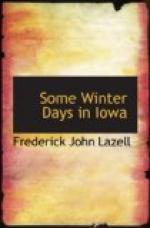The river, away down below, begins to boom and crack. The ice is like the tight head of a big bass drum, but the drummer is inside and the sound comes muffled. The frost is the peg which tightens all the strings of earth and makes them vibrant. The tinkle of sleigh bells on the wagon road fully a mile away comes with peculiar clearness.
When the sun is more than half way from the horizon to the meridian, Nature begins to wake up. A chickadee emerges from his hole in the decaying trunk of a red oak and cheeps softly as he flies to the branch of a slippery elm. His merry “chick-a-dee-dee-dee-dee” brings others of his race, and away they all go down to the red birches on the river bottom. The metallic quanks of a pair of nuthatches call attention to the upper branches of a big white oak. A chickadee and one of the nuthatches see a tempting morsel at the same time. A spiteful peck from nuthatch leaves him master of the morsel and the field. But the chickadee does not care. He flies down and spies a stalk of golden-rod above the snow on which there is a round object looking like a small onion. Chickadee doesn’t know that this is the spherical gall of the trypeta solidaginis, but he does know that it contains a fat white grub. He knows, too, that there is a beveled passage leading to a cell in the center and that the outer end of this passage is protected by a membrane window. After some balancing and pirouetting he smashes the window with his bill, runs his long tongue down the passageway, gulps the grub and away he flies to join his comrades down in the birches, chirping gaily as he goes.
Downy woodpecker “pleeks” his happiness as he excavates the twig of a silver maple. Probably he has found the larvae which the wood wasp left there in the fall. The big hairy woodpecker flies across the clearing with a strident scream. Next to the crow and the jay he is the noisiest fellow in the winter woods. He hammers away at a decaying basswood and the chips which fall are an inch and a half long. His hammering is almost as loud as the bark of a squirrel in the trees across the river. The blood-red spot on the back of his head has an exquisite glow in the sunshine, and you get a fine look at it, for he is busily working little more than a rod from where you stand. He does wonderful work with that strong bill. One decaying basswood found recently was eighteen inches in diameter and the woodpeckers had drilled big holes clear through it. The pile of their chips at the base would have filled a bushel basket.
By the time you have reached the spring the woods are full of life and sound, and the spring itself adds to the winter music. The rocks where it bubbles out are thickly covered with hoar frost. One of the big blocks of limestone in its causeway is covered with ice, clear and viscid as molten glass. The river is bridged over with ice twenty inches thick, save only the little gulf stream into which the spring




